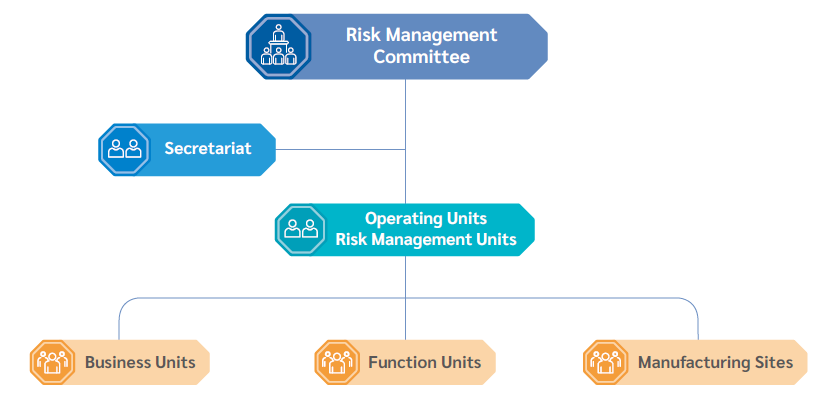
Operation and Governance
Enterprise Risk Management
To ensure sustainable business achievements, USI follows internal audit mechanism to organize a Risk Management Committee to execute annual risk management activities according to business environment, industrial trend, and company operations. The operating units of Risk Management Committee are responsible for the first line risks management to identify the internal and external risk factors, evaluate the risk levels, and inspect the effectiveness of activities. According to evaluation of risk level, the committee takes the responsibility to adopt countermeasures and ensure the risk management policy can be executed by each operation unit. The Risk Management Committee takes the second line responsibility, committee secretariat will track the targets of risk management activities from each operating unit. And the achievements will be presented to Vice President of the Risk Management unit. To cultivate risk awareness, USI arranged training courses for board members, and held Risk Management Introduction for Mainland China, Taiwan, Mexico, and Vietnam employees by online course. It is expected to reduce crisis through risk prevention and monitoring process.

Through worldwide manufacturing sites, business units and functional units, USI engages Enterprise Risk Management (ERM) to identify risk events and factors, evaluate and adopt proper countermeasures. Through monitoring progress of risk mitigation plans to ensure the risks are effective controlled and convert the corporate risk management actions to the organization strategies enhancement to ensure sustainable management and achieve business operational goals. The Risk Management Committee will review the company's exposure twice per year. In the mid-year, the committee decides USI focused risks based on macroeconomic situation and worldwide operational risks (Top-down). In the end-year, the committee reviews internal operational risks identified by business units, manufacturing sites and functional units (Bottom-up).
ERM Process:

USI risk assessment mechanism of internal control system is as below:
1. Define clear objectives to enable risk identification.
2. Assess potential risks for achieving company objectives across the entity and its potential for fraud, then analyze these risks as the basis for risk management.
3. Identify and assess changes that could significantly impact the internal control system.
As global risks continue to rise, if a factory is damaged or ceases operation due to hazardous risks, it may reduce production capacity and lead to the loss of important customers, and have a significant adverse impact on the company's operations and financial performance. By implementing a Business Continuity Management System (BCMS), an organization can increase its resilience and ability to recover from disruptive events, and develop plans and procedures to ensure the continuity of its operations in the event of a disruption.
Business Continuity Management Policy
- USI's operation management shall have risk awareness, and integrate risk management into the business strategy and organizational culture to meet the commitment of applicable requirements.
- Establish a management and risk response mechanism for identification, assessment, and control of major risks, and perform business impact analysis in accordance with operational objectives to establish business continuity objectives, strategies, and plans, and continue to improve. Embed crisis management into employees' awareness and skills and conduct regular drills to ensure effectiveness.
- Openly and actively communicate risk information with stakeholders.
|
BCMS Milestones |
2022 KPIs | 2026 Objectives |
|---|---|---|
| Nantou Plant Passed ISO 22301 Verification | Introduce BCMS to worldwide critical sites |


